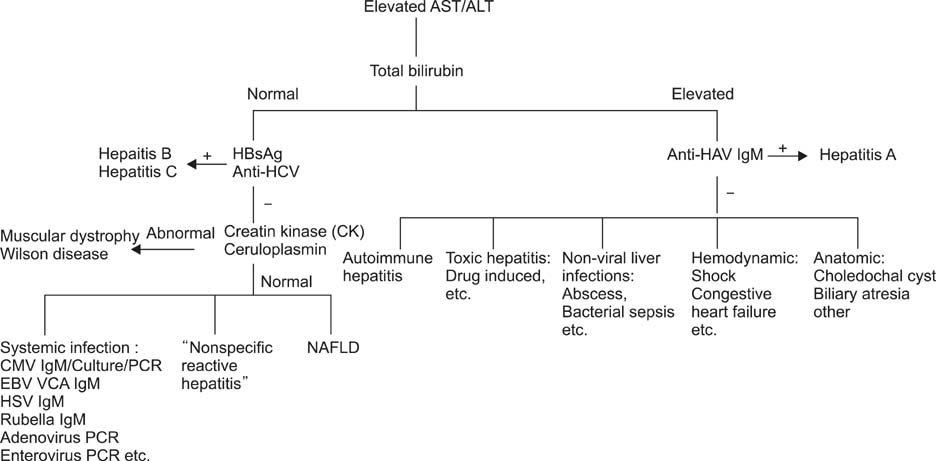Pediatr Gastroenterol Hepatol Nutr.
2013 Dec;16(4):225-232.
Abnormality on Liver Function Test
- Affiliations
-
- 1Department of Pediatrics, Jeju National University School of Medicine, Jeju, Korea. kskang@jejunu.ac.kr
Abstract
- Children with abnormal liver function can often be seen in outpatient clinics or inpatients wards. Most of them have respiratory disease, or gastroenteritis by virus infection, accompanying fever. Occasionally, hepatitis by the viruses causing systemic infection may occur, and screening tests are required. In patients with jaundice, the tests for differential diagnosis and appropriate treatment are important. In the case of a child with hepatitis B virus infection vertically from a hepatitis B surface antigen positive mother, the importance of the recognition of immune clearance can't be overstressed, for the decision of time to begin treatment. Early diagnosis changes the fate of a child with Wilson disease. So, screening test for the disease should not be omitted. Non-alcoholic fatty liver disease, which is mainly discovered in obese children, is a new strong candidate triggering abnormal liver function. Muscular dystrophy is a representative disease mimicking liver dysfunction. Although muscular dystrophy is a progressive disorder, and early diagnosis can't change the fate of patients, it will be better to avoid parent's blame for delayed diagnosis.
Keyword
MeSH Terms
-
Ambulatory Care Facilities
Child
Delayed Diagnosis
Diagnosis, Differential
Early Diagnosis
Fatty Liver
Fever
Gastroenteritis
Hepatitis
Hepatitis B Surface Antigens
Hepatitis B virus
Hepatolenticular Degeneration
Humans
Inpatients
Jaundice
Liver Diseases
Liver Function Tests*
Liver*
Mass Screening
Mothers
Muscular Dystrophies
Viruses
Hepatitis B Surface Antigens
Figure
Reference
-
1. Yazigi N, Balistreri WF. Viral hepatitis. In : Kliegman RM, Stanton BF, St. Geme lll JW, Schor NF, Behrman RE, editors. Nelson textbook of pediatrics. 19th ed. Philadelphia: Elsevier Saunders;2011. p. 1393–1394.2. Misdraji J. Embriology, anatomy, histology, and developmental anomalies of the liver. In : Feldman M, Friedman LS, Brandt LJ, editors. Sleisenger and Fordtran's gastrointestinal and liver disease. 9th ed. Philadelphia: Elsevier Saunders;2010. p. 1201–1206.3. McLin VA, Yagzi N. Developmental anatomy and physiology of the liver and bile ducts. In : Wyllie R, Hyams JS, editors. Pediatric gastrointestinal disease. 4th ed. Philadelphia: Elsevier Saunders;2011. p. 718–727.4. Davenport M. Anatomy and embriology. In : Kleinman RE, Sanderson IR, Goulet O, Sherman PM, Mieli-Vergani G, Shneider BL, editors. Walker's pediatric gastrointestinal disease: physiology, diagnosis, management. 5th ed. Hamilton: BC Decker;2008. p. 749–766.5. Roy-Chowdhury N, Roy-Chowdhury J. Liver physiology and energy metabolism. In : Feldman M, Friedman LS, Brandt LJ, editors. Sleisenger and Fordtran's gastrointestinal and liver disease. 9th ed. Philadelphia: Elsevier Saunders;2010. p. 1207–1225.6. Pratt DS. Liver chemistry and function tests. In : Feldman M, Friedman LS, Brandt LJ, editors. Sleisenger and Fordtran's gastrointestinal and liver disease. 9th ed. Philadelphia: Elsevier Saunders;2010. p. 1227–1237.7. Kim KM. The interpretation of abnormal liver function test in children. In : 2010 Spring Symposium; Seoul: The Society of Korean Pediatric Gastroenteroloy and Nutrition;2010. p. 70–76.8. Bergeron M, Gourley GR. Bilirubin metabolism. In : Kleinman RE, Sanderson IR, Goulet O, Sherman PM, Mieli-Vergani G, Shneider BL, editors. Walker's pediatric gastrointestinal disease: physiology, diagnosis, management. 5th ed. Hamilton: BC Decker;2008. p. 749–766.9. Cho KY. Hepatitis A. Korean J Pediatr Gastroenterol Nutr. 2010; 13:Suppl 1. S70–S77.
Article10. Kim JH. Recent epidemiological status and vaccination of hepatitis A in Korea. J Korean Med Assoc. 2008; 51:110–118.
Article11. Youn HS. Current status of hepatitis A virus infections in Korea. Korean J Pediatr. 2008; 51:690–695.
Article12. Choe BH. Hepatitis B vaccine: prevention of perinatal infection and management of nonresponder. Korean J Pediatr Gastroenterol Nutr. 2007; 10:Suppl 1. 91–100.13. Choe YH, Seo JK, Yun JH, Lee HS. Recent changes in prevalence of hepatitis B viral markers in preschool children in Seoul, 1995. J Korean Pediatr Soc. 1996; 39:1254–1259.14. Choe BH, Hepatitis B. An HS, editor. Hong Change Yee Pediatrics. 10th ed. Seoul: MiraeN Inc.;2012. p. 551–555.15. Kang HS, Kang KS, Song BC. Precore and core promoter mutations of the hepatitis B virus gene in chronic genotype C-infected children. J Korean Med Sci. 2011; 26:546–550.
Article16. Park HJ, Chu MA, Hong SJ, Choe B. The rate of conversion to immune-reactive phase form immune-tolerant phase in children with chronic hepatitis B. 4th WCPGHAN 2012 [abstract] book. p. 68. (OP-1-4-3).17. Robert P, Hepatitis B, Hepatitis D. Feldman M, Friedman LS, Brandt LJ, editors. Sleisenger and Fordtran's gastrointestinal and liver disease. 9th ed. Philadelphia: Elsevier Saunders;2010. p. 1287–1312.18. Seo JK. Diagnosis of Wilson disease in young children: molecular genetic testing and a paradigm shift from the laboratory diagnosis. Pediatr Gastroenterol Hepatol Nutr. 2012; 15:197–209.
Article19. Seo JK, Kim JW. Mutation analysis of Wilson disease gene: Arg778Leu mutation in Korean children. Korean J Pediatr Gastroenterol Nutr. 1999; 2:164–168.
Article20. Yang HR, Ko JS, Seo JK. Role of tumor necrosis factor-α promoter polymorphism and insulin resistance in the development of non-alcoholic fatty liver disease in obese hildren. Pediatr Gastroenterol Hepatol Nutr. 2012; 15:44–51.
Article21. Sarnat HB. Muscular dystrophies. In : Kliegman RM, Stanton BF, St. Geme lll JW, Schor NF, Behrman RE, editors. Nelson textbook of pediatrics. 19th ed. Philadelphia: Elsevier Saunders;2011. p. 2119–2122.
- Full Text Links
- Actions
-
Cited
- CITED
-
- Close
- Share
- Similar articles
-
- Distribution of Diseases Causing Liver Function Test Abnormality in Children and Natural Recovery Time of the Abnormal Liver Function
- Interpretation of Liver Function Tests
- Allopurinol Induced Abnormalities of Liver Function Test in Gout Patients
- The Prevalence of Childhood and Adolescent Obesity in Jeju and Clinical Characteristics according to the Degree of Obesity
- A Diagnostic Approach to Abnormal Liver Function Tests in Asymptomatic Patients


